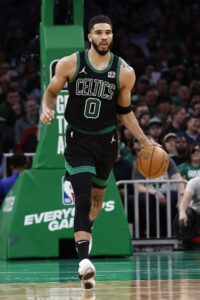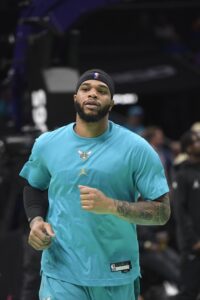There are a number of ways that NBA teams without salary cap space are able to add players. When we discuss trades and free agency at Hoops Rumors, we’ll often refer to these salary cap “exceptions.”
In case you’re wondering what exactly we mean when we mention a “Non-Bird exception” or a “bi-annual exception,” we’ve compiled a brief overview for reference. The NBA’s salary cap exceptions found in the latest Collective Bargaining Agreement are listed below, along with links to more extensive glossary entries on each exception.
- Bird Exception: If a player has been on the same team for three years (not necessarily full seasons), his team can re-sign him for up to the player’s maximum salary. Generally, a player who changes teams via trade retains his Bird rights, but he loses them if he signs with a new team as a free agent. A Bird player can sign for up to five years with maximum annual raises of 8%.
- For further reference: Hoops Rumors Glossary: Bird Rights
- Early Bird Exception: If a player has been on the same team for two years (not necessarily full seasons), his team can re-sign him for up to 175% of his previous salary or 105% of the average player salary from the previous season, whichever is greater. Early Bird contracts must be for at least two seasons (no more than four), with maximum annual raises of 8%.
- For further reference: Hoops Rumors Glossary: Early Bird Rights
- Non-Bird Exception: If a player finishes a season with a team without having earned Bird or Early Bird rights, his team can re-sign him for 120% of his previous salary, 120% of the applicable minimum salary, or – if he’s a restricted free agent – the amount of his qualifying offer. A Non-Bird player can sign for up to four years with maximum annual raises of 5%.
- For further reference: Hoops Rumors Glossary: Non-Bird Rights
- Non-Taxpayer Mid-Level Exception: A team operating below the first tax apron can offer a player a contract for up to four years with maximum annual raises of 5% using the mid-level exception. The MLE amount for 2024/25 is $12,822,000; it will increase annually at the same rate as the salary cap. This exception, which can be used on one or multiple players, can also be used to acquire players via trade or waiver claim.
- For further reference: Hoops Rumors Glossary: Mid-Level Exception
- Taxpayer Mid-Level Exception: A team operating below the second tax apron can offer a player a contract for up to two years with a maximum second-year raise of 5% using the mid-level exception. The taxpayer MLE amount for 2024/25 is $5,168,000; it will increase annually at the same rate as the salary cap. This exception, which can be used on one or multiple players, can only be used to sign players, not to acquire them via trade or waiver claim.
- For further reference: Hoops Rumors Glossary: Mid-Level Exception
- Room Exception: If a team uses room under the cap to sign players, it forfeits its full mid-level exception and receives this exception, which isn’t available to teams above the cap. After using its cap room, a team can offer a player a contract for up to three years with maximum annual raises of 5%. The room exception amount for 2024/25 is $7,983,000; it will increase annually at the same rate as the salary cap. This exception, which can be used on one or multiple players, can also be used to acquire players via trade or waiver claim.
- For further reference: Hoops Rumors Glossary: Mid-Level Exception
- Bi-Annual Exception: A team can offer a player a contract for up to two years with a maximum raise of 5% using the bi-annual exception. However, it’s only available to teams that operate over the cap and below the first tax apron. The bi-annual exception amount for 2024/25 is $4,668,000; it will increase annually at the same rate as the salary cap. This exception, which can be used on one or multiple players, can also be used to acquire players via trade or waiver claim. As its name suggests, the bi-annual exception can only be used every other year.
- For further reference: Hoops Rumors Glossary: Bi-Annual Exception
- Minimum Salary Exception: A team can offer a player a contract for up to two years worth the applicable minimum salary. A team can also use this exception to trade for minimum-salary players, as long as their contracts don’t cover more than two seasons and never included a salary above the minimum. There is no limit to the number of players a team can acquire using this exception.
- For further reference: Hoops Rumors Glossary: Minimum Salary Exception
- Rookie Scale Exception: A team can sign its first-round draft picks for up to 120% of the rookie salary scale amount or as little as 80% of the rookie salary scale amount. The rookie salaries for 2024 first-round picks can be found right here. The rookie scale increases annually at the same rate as the salary cap.
- For further reference: Hoops Rumors Glossary: Rookie Scale Exception
- Second-Round Pick Exception: A team can sign a second-round pick to a three- or four-year contract with a team option on the final year. A contract signed using the second-round exception can exceed the applicable rookie minimum in the first year (or the first two years, for a four-year deal), but not in the final two years. The details for second-round pick exception signings in 2024/25 can be found right here.
- For further reference: Hoops Rumors Glossary: Second-Round Pick Exception
- Disabled Player Exception: If a player suffers an injury deemed more likely than not to sideline him through the following June 15, a team can be granted this exception by the league. It can be used to sign a replacement player for one year, and is worth 50% of the disabled player’s salary or the amount of the non-taxpayer mid-level exception, whichever is lesser. It can also be used to acquire a player via trade or waiver claim if he’s in the final year of his contract. This exception, which must be applied for between July 1 and January 15, can only be used once and is forfeited if not used by March 10 (or the next business day, if March 10 falls on a weekend).
- For further reference: Hoops Rumors Glossary: Disabled Player Exception
- Traded Player Exception: Any team can replace a traded player – or traded players – simultaneously (in the same transaction) with one or more players whose total salaries amount to no more than 100% of the outgoing salary. For teams operating below the tax aprons, the incoming value can increase to as high as 200% of the outgoing salary (plus $250K), depending on the amount of that salary. Alternately, both non-taxpaying and taxpaying teams can replace a traded player non-simultaneously (within one year) with one or more players whose total salaries amount to no more than 100% of the traded player’s salary.
- For further reference: Hoops Rumors Glossary: Traded Player Exception
Note: This is a Hoops Rumors Glossary entry. Our glossary posts will explain specific rules relating to trades, free agency, or other aspects of the NBA’s Collective Bargaining Agreement.
Earlier versions of this post were published in 2012 and 2018.
 [RELATED:
[RELATED: 
 The Hornets’ 2024 lottery pick doesn’t come without risk either, albeit for entirely different reasons —
The Hornets’ 2024 lottery pick doesn’t come without risk either, albeit for entirely different reasons — 